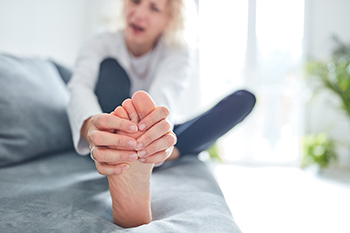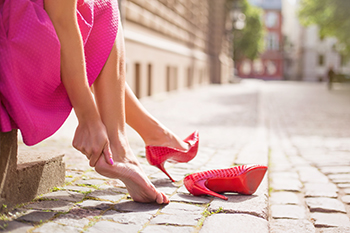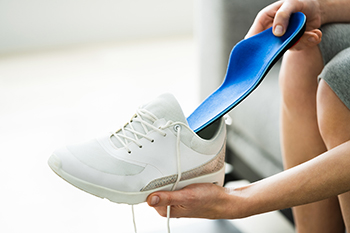July 2023
Sever’s Disease Affects Young Athletes

There is a part of the heel that is known as the calcaneal apophysis. This is the growth center that connects the Achilles tendon to the heel. It can become inflamed in active children and young teenagers from participating in running and jumping activities. This can cause excessive tension on the Achilles tendon, and heel pain can ensue. This condition is called Sever’s disease and can worsen when the offending activity is pursued. The pain can also affect the calf muscle and may be more severe in people who have flat feet. An X-ray can be performed which can determine the maturity of the growth center, and can also help rule out a stress fracture. Treatment can begin with temporarily stopping the activity that caused the pain and resting the foot as often as possible. There are specific stretches that can be performed for the heel and Achilles tendon. If your child has Sever’s disease, it is suggested that you schedule an appointment with a podiatrist who can effectively treat this condition.
Sever's disease often occurs in children and teens. If your child is experiencing foot or ankle pain, see one of our podiatrists from Family Foot Care. Our doctors can treat your child’s foot and ankle needs.
Sever’s Disease
Sever’s disease is also known as calcaneal apophysitis, which is a medical condition that causes heel pain I none or both feet. The disease is known to affect children between the ages of 8 and 14.
Sever’s disease occurs when part of the child’s heel known as the growth plate (calcaneal epiphysis) is attached to the Achilles tendon. This area can suffer injury when the muscles and tendons of the growing foot do not keep pace with bone growth. Therefore, the constant pain which one experiences at the back of the heel will make the child unable to put any weight on the heel. The child is then forced to walk on their toes.
Symptoms
Acute pain – Pain associated with Sever’s disease is usually felt in the heel when the child engages in physical activity such as walking, jumping and or running.
Highly active – Children who are very active are among the most susceptible in experiencing Sever’s disease, because of the stress and tension placed on their feet.
If you have any questions, please feel free to contact our offices located in Valatie and Albany, NY . We offer the newest diagnostic and treatment technologies for all your foot and ankle injuries.
Various Reasons to Have Foot Pain

The feet provide us with mobility, and enable people to participate in running, walking, and jumping activities. An individual person will walk 100,000 miles during the course of an average lifetime, and research has shown that many people spend approximately 80 percent of their waking hours on their feet. This being said, it is beneficial to keep the feet as healthy as possible in order to prevent unwanted foot conditions from developing. Some of these ailments can consist of hammertoe, foot cramps, ingrown toenails, or bunions. Many of these can be remedied by purchasing shoes that fit correctly, in addition to maintaining proper foot care. Diabetic patients may be prone to developing foot ulcers. This is defined as an infection that develops on the sole of the foot, and can happen from the inability to feel existing cuts. If you have foot pain, it is strongly suggested that you confer with a podiatrist who can determine what the cause is, and treat it effectively.
Foot Pain
Foot pain can be extremely painful and debilitating. If you have a foot pain, consult with one of our podiatrists from Family Foot Care. Our doctors will assess your condition and provide you with quality foot and ankle treatment.
Causes
Foot pain is a very broad condition that could be caused by one or more ailments. The most common include:
- Bunions
- Hammertoes
- Plantar Fasciitis
- Bone Spurs
- Corns
- Tarsal Tunnel Syndrome
- Ingrown Toenails
- Arthritis (such as Gout, Rheumatoid, and Osteoarthritis)
- Flat Feet
- Injury (from stress fractures, broken toe, foot, ankle, Achilles tendon ruptures, and sprains)
- And more
Diagnosis
To figure out the cause of foot pain, podiatrists utilize several different methods. This can range from simple visual inspections and sensation tests to X-rays and MRI scans. Prior medical history, family medical history, and any recent physical traumatic events will all be taken into consideration for a proper diagnosis.
Treatment
Treatment depends upon the cause of the foot pain. Whether it is resting, staying off the foot, or having surgery; podiatrists have a number of treatment options available for foot pain.
If you have any questions, please feel free to contact our offices located in Valatie and Albany, NY . We offer the newest diagnostic and treatment technologies for all your foot care needs.
Are You Suffering From Ingrown Toenails?
Wearing High Heels Can Cause Foot Problems

High-heeled shoes are the cause of many foot problems, and experts agree the higher the heel, the worse they are for your feet. When high heeled shoes also have a narrow and pointy toe box, they may become even more destructive. Add to that strappy sandals with minimal support and thin soles, and the situation worsens. Specifically, high heels force the weight of the body onto the metatarsals and sesamoid bones of the feet. This excess pressure in turn causes inflammation of the surrounding nerves. In some cases, hairline breaks in the bones, called stress fractures, can develop. In addition, the likelihood of tripping and spraining an ankle increases while wearing high heels. The answer may be simply changing your footwear or limiting the amount of time spent wearing high heels. Shoes with heels no higher than two inches are thought to be less harmful. Look for shoes with a wider toe box that allows freedom of movement for the toes and thicker heels for increased stability. For help with foot problems stemming from wearing high heels long term, it is suggested that you make an appointment with a podiatrist.
High heels have a history of causing foot and ankle problems. If you have any concerns about your feet or ankles, contact one of our podiatrists from Family Foot Care. Our doctors can provide the care you need to keep you pain-free and on your feet.
Effects of High Heels on the Feet
High heels are popular shoes among women because of their many styles and societal appeal. Despite this, high heels can still cause many health problems if worn too frequently.
Which Parts of My Body Will Be Affected by High Heels?
- Ankle Joints
- Achilles Tendon – May shorten and stiffen with prolonged wear
- Balls of the Feet
- Knees – Heels cause the knees to bend constantly, creating stress on them
- Back – They decrease the spine’s ability to absorb shock, which may lead to back pain. The vertebrae of the lower back may compress.
What Kinds of Foot Problems Can Develop from Wearing High Heels?
- Corns
- Calluses
- Hammertoe
- Bunions
- Morton’s Neuroma
- Plantar Fasciitis
How Can I Still Wear High Heels and Maintain Foot Health?
If you want to wear high heeled shoes, make sure that you are not wearing them every day, as this will help prevent long term physical problems. Try wearing thicker heels as opposed to stilettos to distribute weight more evenly across the feet. Always make sure you are wearing the proper shoes for the right occasion, such as sneakers for exercising. If you walk to work, try carrying your heels with you and changing into them once you arrive at work. Adding inserts to your heels can help cushion your feet and absorb shock. Full foot inserts or metatarsal pads are available.
If you have any questions please feel free to contact our offices located in Valatie and Albany, NY . We offer the newest diagnostic and treatment technologies for all your foot and ankle needs.
Benefits of Shoe Inserts for Plantar Fasciitis

Anyone with plantar fasciitis knows how much pain it can cause, and one of the ways to ease that pain is by using shoe inserts, or orthotics. The plantar fascia is a band of tissue that runs along the sole of the foot. When this tissue is torn from overuse, it becomes inflamed and a stabbing pain is mostly felt in the heel and arch. One of the major causes of plantar fasciitis is improper footwear. It is especially common in runners and women who frequently wear high heels. Shoes should have the proper arch support as well as ample cushioning to absorb shock. Special orthotics may be helpful in this regard, particularly in people with flat feet, high arches, or other biomechanical foot conditions. In these cases, ready-made shoe inserts may not be able to solve the problem. Custom orthotics made by a podiatrist can be exceedingly helpful because they are constructed to fit the contours of your feet perfectly and correct the problem areas. For more information, it is suggested that you make an appointment with a podiatrist for an exam.
If you are having discomfort in your feet and would like to try orthotics, contact one of our podiatrists from Family Foot Care. Our doctors can provide the care you need to keep you pain-free and on your feet.
What Are Orthotics?
Orthotics are inserts you can place into your shoes to help with a variety of foot problems such as flat feet or foot pain. Orthotics provide relief and comfort for minor foot and heel pain but can’t correct serious biomechanical problems in your feet.
Over-the-Counter Inserts
Orthotics come in a wide variety of over-the-counter inserts that are used to treat foot pain, heel pain, and minor problems. For example, arch supports can be inserted into your shoes to help correct overarched or flat feet, while gel insoles are often used because they provide comfort and relief from foot and heel pain by alleviating pressure.
Prescription Orthotics
If over-the-counter inserts don’t work for you or if you have a more severe foot concern, it is possible to have your podiatrist prescribe custom orthotics. These high-quality inserts are designed to treat problems such as abnormal motion, plantar fasciitis, and severe forms of heel pain. They can even be used to help patients suffering from diabetes by treating foot ulcers and painful calluses and are usually molded to your feet individually, which allows them to provide full support and comfort.
If you are experiencing minor to severe foot or heel pain, it’s recommended to speak with your podiatrist about the possibilities of using orthotics. A podiatrist can determine which type of orthotic is right for you and allow you to take the first steps towards being pain-free.
If you have any questions please contact our offices located in Valatie and Albany, NY . We offer the newest diagnostic and treatment technologies for all your foot and ankle needs.




